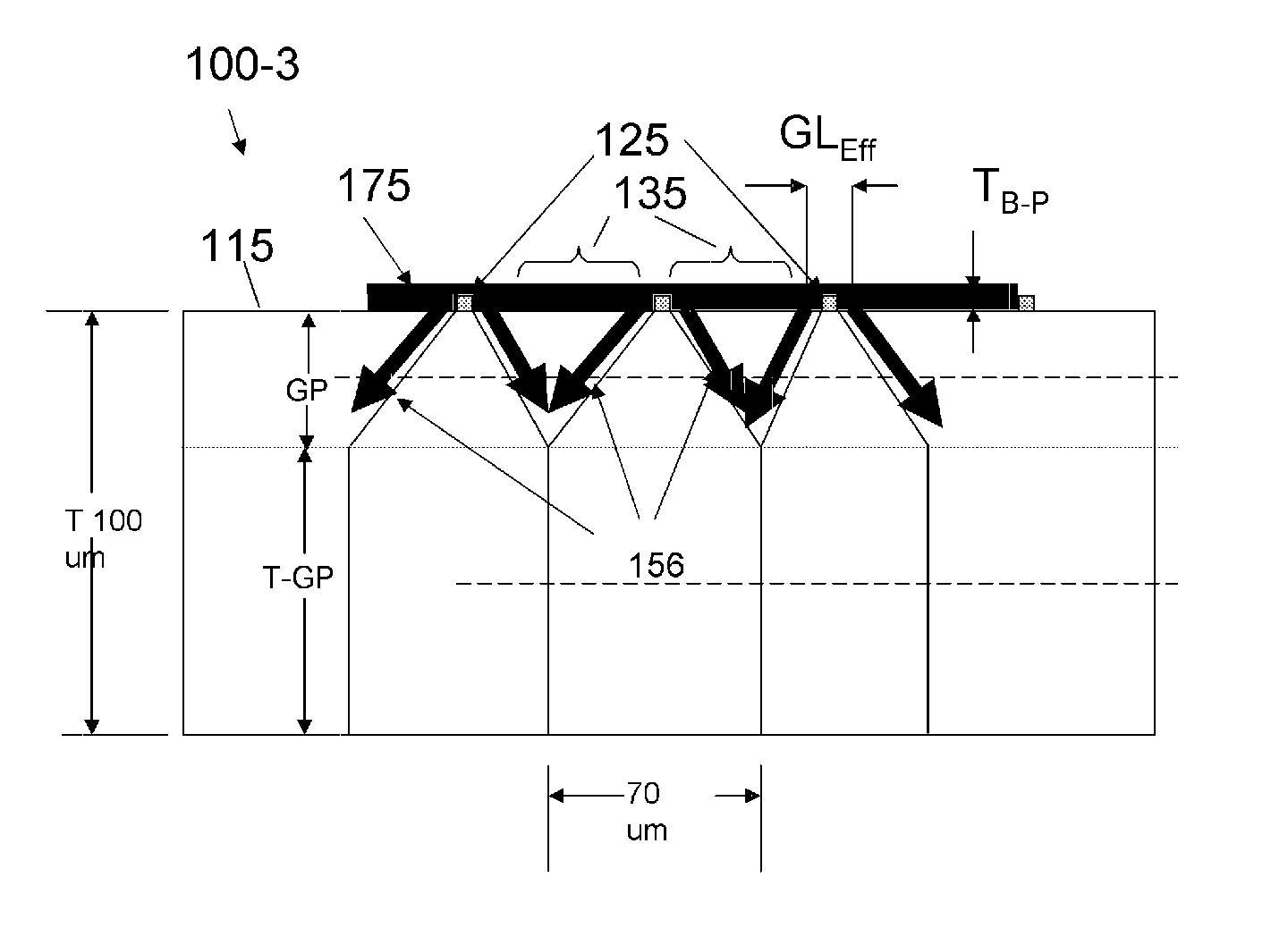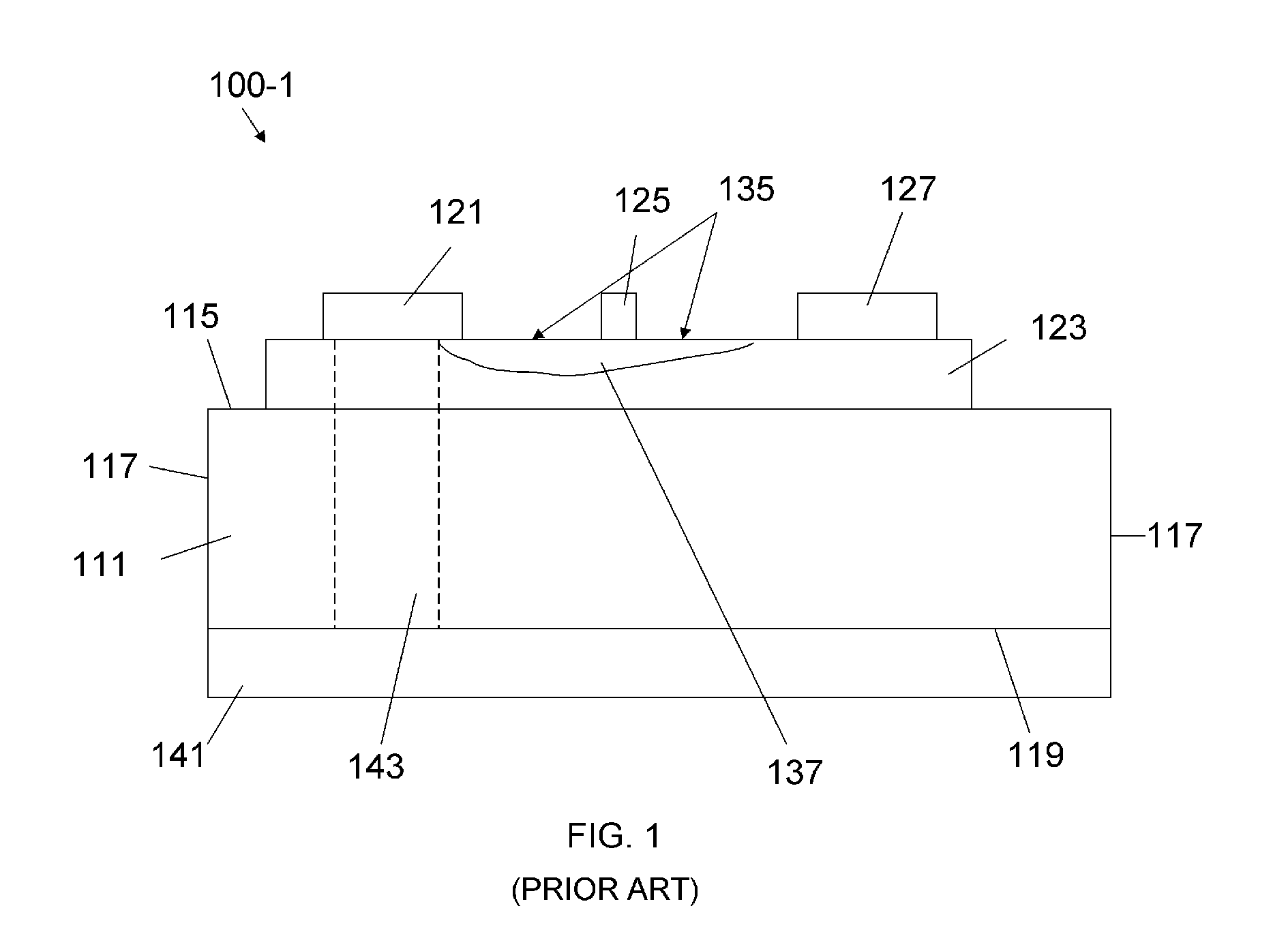Topside Thermal Management of Semiconductor Devices
a topside heat sinking and semiconductor technology, applied in semiconductor devices, semiconductor/solid-state device details, electrical devices, etc., can solve the problems of limiting the effect of additional topside heat sinking, current approaches do not yet offer optimal thermal management, and the demands are literally daily increased, so as to improve thermal management and improve thermal management.
- Summary
- Abstract
- Description
- Claims
- Application Information
AI Technical Summary
Benefits of technology
Problems solved by technology
Method used
Image
Examples
example 1a
Baseline Thermal Impedance in SiC Substrate with 10 W / mm Output
[0025]
Output StageOutput Power density10 W / mmGate Width0.5 mmGate Pitch0.07 mmGate Length0.0004 mmHeatsink Temp100 deg C.Chip thickness0.1 mmCalibration temp25 deg C.Gain drift−0.015 dB / deg C.ss gain9.5 dBGain Compression2 dBefficiency65%Thermal conductivity0.268 w / mm-deg C.Theta Chip15.3 deg C. / WSingle Gate PD3.84 WDelta T chip58.9 deg C.T chip158.9 deg C.Gain correction−1.125Input power density2.30 W / mm
[0026] Note that the gate length is equal to 0.0004 mm and the calculated chip temperature Tchip equal to 158.9° C.
example 1b
Improved Thermal Impedance in SiC Substrate with 10 W / mm Output
[0027]
Output Stageoutput power density10 W / mmGate Width0.5 mmGate pitch0.07 mmEff. Gate Length0.0354 mmHeatsink Temp100 deg C.Chip thickness0.1 mmCalibration temp25 deg C.Gain drift−0.015 deg C.ss gain9.5 dBgain compression2 dBefficiency65%Thermal conductivity0.268 w / mm deg C.Theta chip8.90 deg C. / WSingle gate PD3.84 WDelta T chip34.2 deg C.T chip134.2 deg C.Gain correction−1.125Input power density2.30 W / mm
[0028] The effective gate length GLEFF increased to 0.0354 mm from the actual gate length GL of 0.0004 mm (Example 1a) due to the simulated boron phosphide coating as illustrated in FIG. 3A. The calculated chip temperature Tchip became 134.2° C. The thermal improvement, expressed as the difference in the chip temperatures, was about 25° C.
example 2a
Baseline Thermal Impedance in GaAs Substrate with 0.7 W / mm Output
[0029]
Output Stageoutput power Density0.7 W / mmGate Width0.5 mmGate pitch0.032 mmGate Length0.0005 mmHeatsink Temp80 deg C.Chip thickness0.1 mmCalibration temp25 deg C.Gain drift−0.015 dB / deg C.ss gain11 dBgain compression4 dBefficiency52%Thermal conductivity0.04 w / mm-deg C.Theta chip175.2 deg C. / WSingle gate PD0.408 WDelta T chip71.4 deg C.T chip151.4 deg C.Gain correction−0.825input power0.169 W / mmdensity
[0030] Note the actual gate length equal to 0.0005 mm and the chip temperature equal to 151.4° C.
PUM
 Login to View More
Login to View More Abstract
Description
Claims
Application Information
 Login to View More
Login to View More - R&D
- Intellectual Property
- Life Sciences
- Materials
- Tech Scout
- Unparalleled Data Quality
- Higher Quality Content
- 60% Fewer Hallucinations
Browse by: Latest US Patents, China's latest patents, Technical Efficacy Thesaurus, Application Domain, Technology Topic, Popular Technical Reports.
© 2025 PatSnap. All rights reserved.Legal|Privacy policy|Modern Slavery Act Transparency Statement|Sitemap|About US| Contact US: help@patsnap.com



